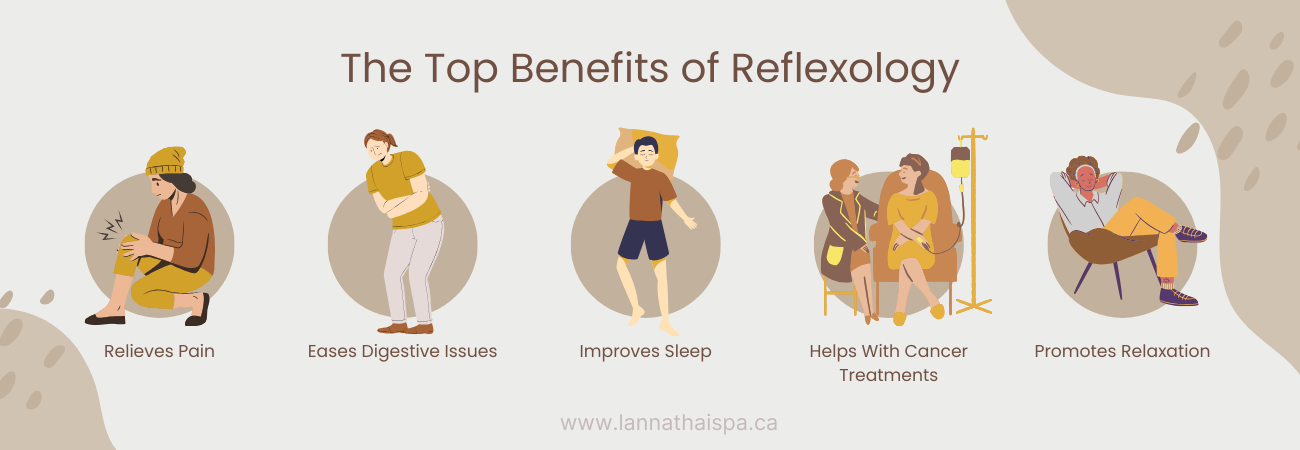Photo Credits to www.zeel.com
Many people think that reflexology is some form of massage, often confusing it with a foot massage. However, reflexology is an entirely different modality. It is a specialized technique that involves applying pressure to specific points on the feet, hands, or ears, which are believed to correspond to different organs and systems in the body. The aim of this practice is to promote healing and well-being through encouraging the body’s natural energy flow and stimulating reflex points.
Reflexology and massage therapy are both beneficial for the mind and body. While similar in practice, there are key differences between the two. In this article, let’s explore reflexology – what it is, its benefits, and its differences from massage therapy.
What Is Reflexology?
Reflexology, along with other modalities like massage therapy, acupuncture, and acupressure, is an ancient practice that has been used for centuries to promote health and wellness. All four modalities bear some similarities to one another.
Linda Frank, a nationally board-certified reflexologist and reflexology instructor, says “We all assist the flow of energy. All four modalities work through the skin and its underlayers.” Today, even with many modern medical advances, plenty of people still look to these ancient medicinal practices for healing and relaxation.
Reflexology involves the application of pressure to specific areas of the hands, feet, and ears which are believed to affect certain reflex areas of the body. There are so called “zones” in the hands and feet that represent certain areas of your body and these areas can be adjusted or managed through the zones. Reflexology has plenty to do with aligning you qi, which is energy in the broadest sense possible.
The Differences Between Reflexology and Massage
In reflexology, certain parts of the hands, feet, and ears are squeezed for healing and relaxation. Reflexologists aim to unblock various neural pathways so that energy and life flows through and heals injuries and illnesses.
On the other hand, massage therapy involves the gentle manipulation of soft tissues in the body, aiming to release tension, relieve pressure, and facilitate relaxation. Therapists will gently rub and knead most parts of the body, as opposed to only the hands, feet, and ears in reflexology.
Massage therapy has a wide range of modalities. Depending on the type of massage that you get, it may involve aromatherapy, heated stones, rolling movements, leans and stretches, heat therapy, rhythmic tapping, yoga, and many more.
Both reflexology and massage use hands on the body for the application of techniques, but there are not any more similarities beyond that. Reflexology focuses on one specific trigger point on your body while massage targets entire muscle groups. While you can complement a massage with a reflexology session, only your hands, feet, and ears will be touched. This means that you don’t need to remove your clothes, as opposed to when you have a massage session.
Reflexology and massage, like many other therapies, use the hands on the body, for the application of their techniques. However, that is where the similarities end. Reflexology is not a massage, in the same way that a massage is not reflexology. While a body massage can be complemented with reflexology, a reflexology session only includes the feet and hands.
The Top Benefits of Reflexology
Reflexology is a unique modality that promotes healing, wellness, and balance. Pressure points in the hands, feet, and ears correspond to various body parts. Squeezing these pressure points provides the body with many benefits. Below are the top benefits of reflexology.

Relieves Pain
Reflexology is known to provide natural pain relief. A 2018 study showed that over 94 percent of 311 participants reported that reflexology helped reduce their pain after just the first session. These were individuals who suffered from chronic musculoskeletal or nerve pain and were each given 25 minutes of foot reflexology. It is also believed that the practice helps ease headaches and chronic low back pain.
Eases Digestive Issues
If you’re having minor stomach issues, a reflexology session might make you feel better. According to a small study on 19 female patients with chronic constipation, more than 94 percent said that they observed an improvement of their constipation symptoms after a six-week course of foot reflexology treatments.
Improves Sleep
Quality sleep is an essential part of our health and well-being, and reflexology has proven that it can help you sleep better. A 2021 review of 42 studies published in the Journal of Advanced Nursing showed that nearly 4,000 patients with sleep troubles reported that reflexology improved their sleep quality. Fewer people also reported disturbances in their sleep since their reflexology sessions.
Helps With Cancer Treatments
Cancer and its treatments can take a significant toll on one’s physical and mental health. While reflexology cannot directly cure cancer, it has shown effectiveness in helping ease the side effects of cancer treatments, such as chemotherapy. A 2019 study involved dividing breast cancer patients undergoing chemotherapy into two groups, one group receiving twice a week reflexology sessions while the other received standard care alone. Those who received reflexology treatments reported feeling more energy and less fatigue at the end of the study.
Promotes Relaxation
As mentioned above, reflexology involves unblocking neural pathways so that energy can flow freely throughout the body. As a result, the mind becomes calmer and the body more relaxed. A 2020 study reviewed 26 clinical trials that had over 2,300 participants. The researchers found that there was a significant improvement in the patients’ anxiety, depression, and sleep quality because of reflexology, concluding that it’s an ideal form of supportive therapy for mental health concerns.
In A Nutshell
Now that you know the major benefits of reflexology, perhaps it’s time that you include it in your wellness routine along with good quality massage sessions. Though it’s considered to be generally safe and low risk, it’s still ideal to consult your doctor before pursuing regular reflexology therapy.



